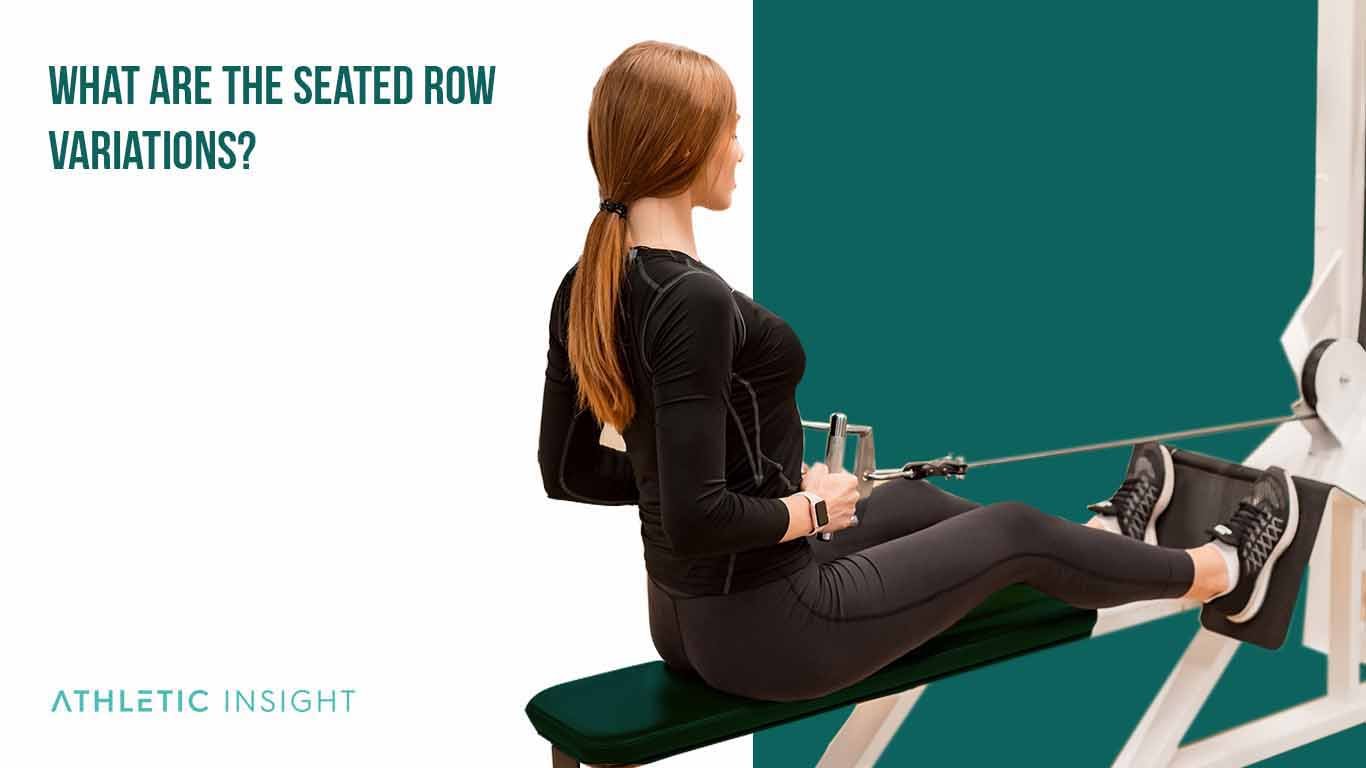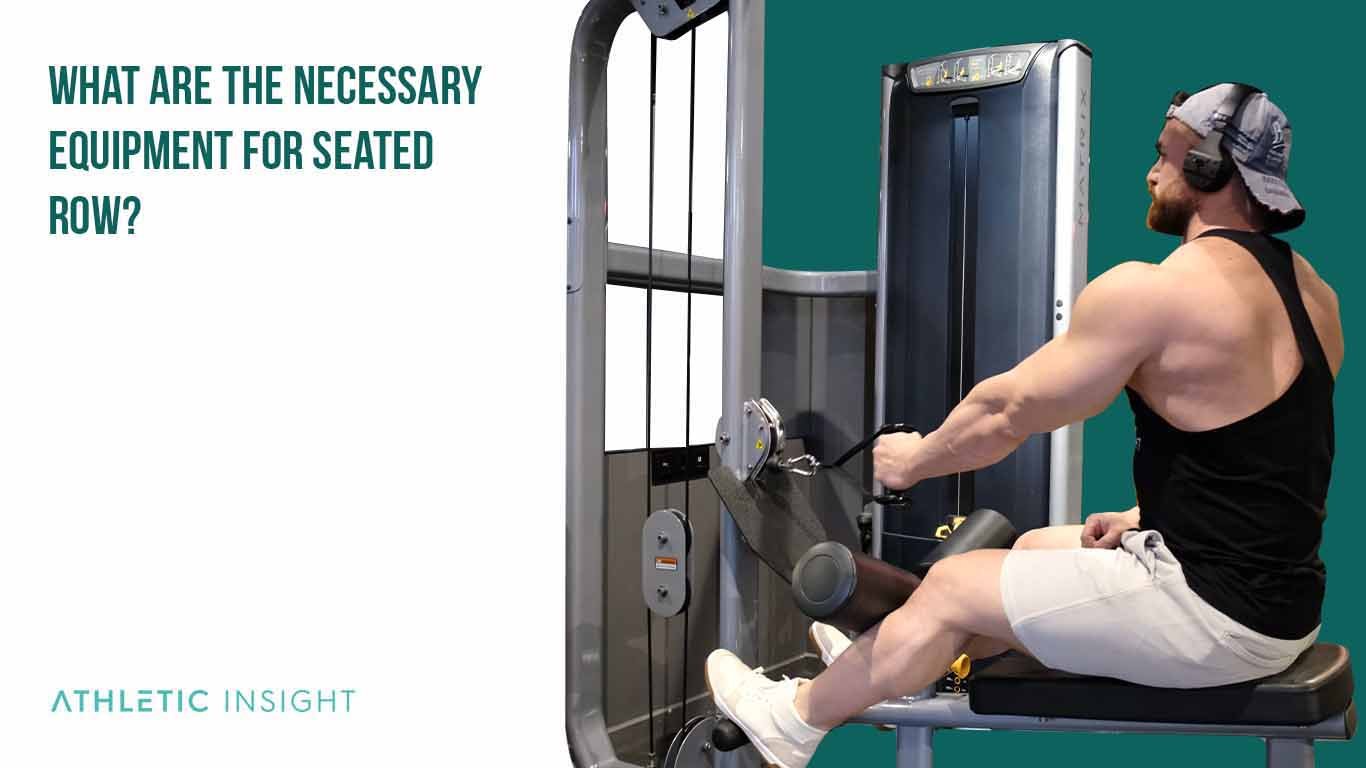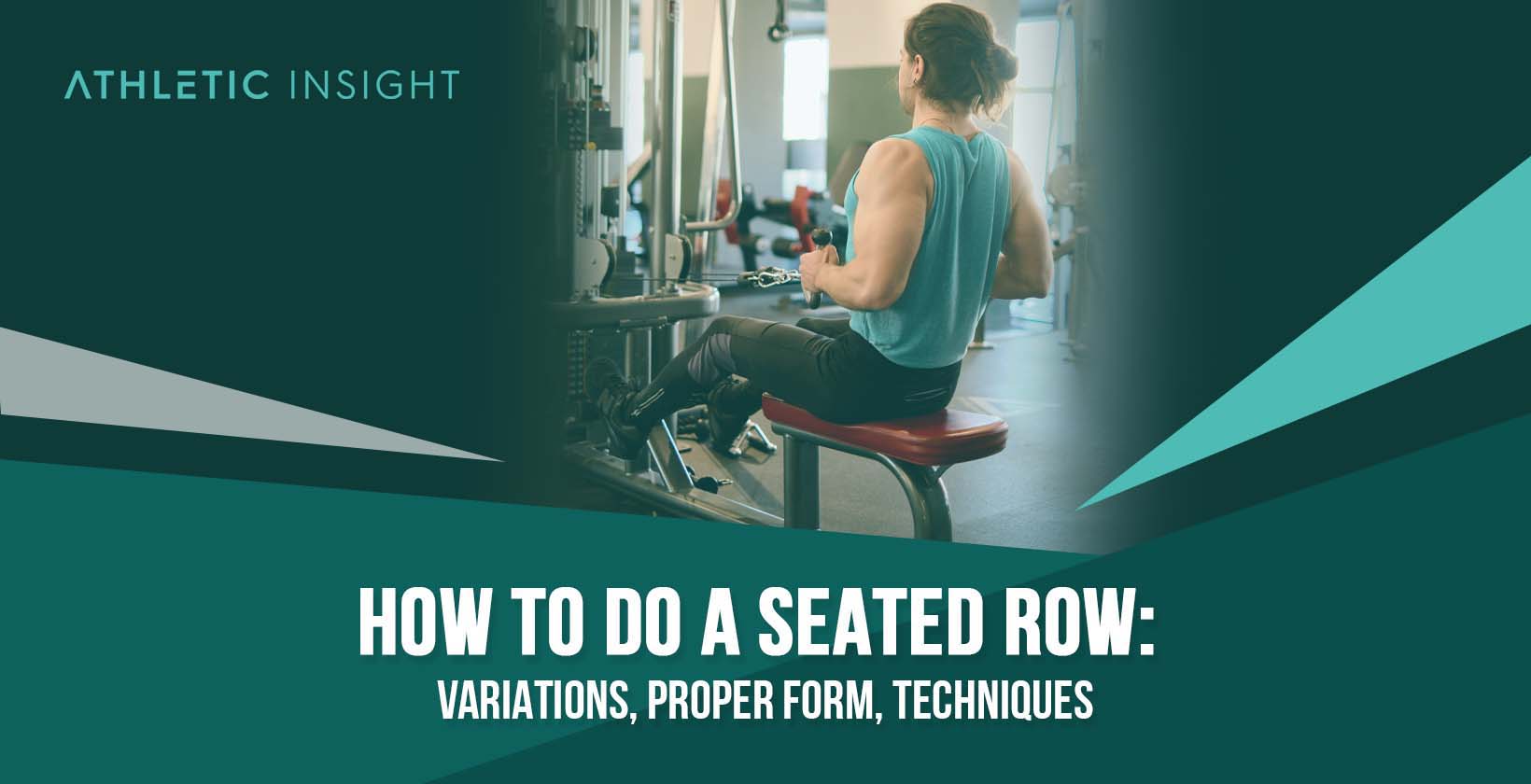The seated row is a compound exercise that works the latissimus dorsi, rhomboids, trapezius, and biceps brachii muscles. It is a beginner-friendly muscle movement for all weightlifters, from sports athletes to Strongmen and bodybuilders.
The main benefits of the seated row include building upper body strength and toning the mirror muscles in your arms and chest. Other benefits include improvements in posture, grip strength, and reducing the risk of injury during other compound lifts.
To perform the seated row, you only need a seat (usually a bench) and some form of resistance (usually a cable machine). The exercise is performed by maintaining a straight back and a tight core. While simultaneously pulling the weight towards your chest in a controlled manner, the weightlifter should be retracting the shoulder blades.
The resistance should not be too difficult where you cannot fully pull the weight to your chest or require coming forward to meet the handles. This, in addition to rounding the back, are the most common form mistakes seen. Not only do these mistakes cheat the movement, but they may also lead to joint pain and muscle damage.
This article will help you master the seated row and its variations while covering proper form, counts, main seated row types, seated row mistakes, and common injuries.
How to Perform Seated Row with Proper Form?
A seated row is generally performed on a specific seated row machine or with a resistance band. Your shoulders should be at the same level as the handles of the machine, and you may need to adjust the machine’s chest or seat pad to be at the proper height.
The proper form for a seated row on a machine involves sitting upright on the machine, knees slightly bent without curling your lower back. You should brace and engage your abdominal muscles and keep your core tight as you perform the exercise.
Complete the following steps to perform a set of seated rows on the machine.
- Sit straight and upright on the bench, knees slightly bent.
- Plant your feet on the machine’s footpads.
- Reach forward and grab the handle (some machines use a cable).
- Move your shoulders back and then down to align with the handles of the machine.
- Engage your core and exhale.
- Pull your arms in, bending your elbows to pull the handle towards your body towards your lower abdomen.
- Keep your elbows tucked in, and don’t strain your back. Concentrate on using the muscles in your arms to pull the weight, not the momentum.
- Keep your back straight, pushing your chest out and shoulders down as you row. You should feel your shoulder blades squeezing together as you pull back.
- Slowly release the row and extend your arms back out as you inhale.
- Release the handle forward to a full stretch while keeping your back straight.
It’s essential to maintain proper form and keep the core engaged, back relaxed, and put most of the work into the arms. The seated row builds and engages the upper arms and back, building the muscles there while reducing injury on your back.
What are the Stages of Conventional Seated Row?
The stages of a seated row involve set up, the pull, and the release.
- When setting up, the optimum degree of the seat is whatever will align your shoulders with the handle or cable.
- Grasp the handle of the weight properly with your palms facing each other.
- Pull the weights towards your torso and hold. Make sure that you are using the proper form to avoid back injury.
- Hold and wait for the desired length of time (about one second), and then slowly release the pull while keeping your arms and core engaged.
- Repeat the stages for the desired amount of reps.
What are the Mistakes for the Seated Row Form?
Like all exercises, use good proper seated row form to be safe and get the most effective workout. Whether you’re using a seated row machine with handles or a cable row machine, the common Seated Row Mistakes are very similar.
- Not bending your knees – Conventional seated row form on a cable row requires you to keep your knees slightly bent. Don’t over or under extend your legs, and don’t lock your knees.
- Not engaging your core – During the rowing motion, keep your abdominal muscles engaged the entire time. Despite being an arm and back exercise, keeping your core engaged will lead to more desirable results and reduce the risk of injury.
- Moving your torso – Avoid moving side to side or forward and back with your torso. This disengages the muscles you’re trying to work out, like the rhomboids and trapezius.
- Improperly bent elbows – Keep your elbows against your torso when in the pulling stage. You don’t want to lift your elbows or let them pull away from your body. This will engage the biceps instead of the rhomboids and latissimus dorsi.
- Shoulders shrugged – Your need to pull your shoulders back and down. This will properly engage the rhomboids between your shoulder blades. Additionally, shrugged shoulders could lead to injury if you shrug them towards your ears during the pull.
- Bent back – Keeping your spring straight and back relaxed during rows is essential. Not only will this put pressure on your upper arms to complete the pull, but it will help prevent back discomfort and injury.
- Moving too quickly – The seated row should be a slow, deliberate exercise. To fully engage the muscle groups in your upper arms and back, avoid moving too quickly and make sure each pull and release are done to the fullest.
- Not enough movement – When pulling back, the row should take your elbows all the way back towards your torso, and each rep should complete the full range of motion.
Following these tips and avoiding these common seated row mistakes will help you develop a better technique and achieve desired results for your arms and back.
Which Muscles are Involved While Performing Seated Row?
When performing a seated row, the muscles involved include the mirror muscles in your arms and back. This consists of the biceps brachii, trapezius, latissimus dorsi, and rhomboids, all musicals located in the back and arms.
The biceps brachii are the “flexing muscles” in your upper arm. Slowly releasing the row engages the biceps, building strength with a slow release. These muscles are considered secondary muscles for this exercise.
The trapezius is the muscle on either side of the neck, a wide, triangular-shaped muscle that controls movement in the neck, shoulders, and upper back. The pulling motion in the seated row helps strengthen the trapezius and improve posture.
The latissimus dorsi, one of the largest muscles in the back, is configured along the spine. Seated rows help build strength here, protecting you from a back injury.
The major rhomboid muscle keeps your shoulder blade attached to your ribcage and is responsible for helping you rotate your shoulder. Since seated row proper form requires keeping your shoulders down and back, it engages and strengthens the rhomboids, protecting your shoulder’s range of motion.
How to Do Seated Row?
All you need to dominate the seated row without a machine is a resistance band.
1. Put your legs together and sit on the floor.
Sitting on the floor allows you to simulate sitting on the machine. Keep your back straight and relaxed, with your shoulders down and back. Doing this will ensure that you primarily work the muscles in your arms and back.
2. Kneel further than 45 degrees.
Keep a slight bend in your knees. You do not want your legs fully outstretched since it will alter the movements of the row.
3. Hold the ends of the band with your palms facing inward and place the band around the soles of your feet.
Loop the resistance band around the bottom of your feet with one handle in each hand. This simulates the position of the cable row machine.
4. Support your core.
The proper form for the seated row involves keeping your core engaged from the moment you get into position. Supporting your core primes you for keeping your arms and back muscles fully engaged without injury.
5. When your elbows are tucked in and your back is neutral, exhale and pull the band until your hands are over your thighs.
This is the row stage. Pull your hands back with your elbows tucked in towards your torso, hands still facing each other. The backward row is complete when your hands are over your thighs. Don’t pull back further than that.
6. Stop for one or two seconds.
Do the row deliberately and slowly, and hold the position for at least two seconds. Do not use the momentum of the row to drive the exercise – slow strength training is the best way to engage and build these muscles in your arms and back.
7. Breathe in and slowly expand your arms, counting to three.
The slow release of the row will engage your biceps. It’s essential to do this step slowly and deliberately, concentrating on the strength in your biceps and back muscles. Count to three to ensure that your extension is full and complete.
8. Finish the set with different reps
You can do two or three sets of up to 60 seconds each. You can do the same amount of reps in 30 seconds if needed. Each set should use slow and smooth, not jerky, movements to fully engage the biceps and back muscles.
What are the Seated Row Challenges?
You can vary your workouts by including these seated row challenges. These popular challenges take the traditional seated row and add varying degrees of difficulty for you to achieve. Another feature of a seated row challenge is uploading them to social media with the appropriate challenge hashtag.

The Seated Row and EMOM (or every-minute-on-the-minute) workout challenge you to complete a certain number of seated row reps in less than 60 seconds. For example, you can challenge yourself to complete 12 reps in less than 60 seconds properly.
Seated Row and GVT (or German Volume Training) involves doing a high number of sets and repetitions to stress the muscles without hurting them. For example, you could do ten seated row sets to stress your arm and back muscles, triggering muscle growth. GVT is a training method bodybuilders use to build muscle size and strength.
You can also test the 1RM with the seated row. The RM (repetition maximum) refers to the most weight you can hold or lift. For a seated row, this would depend on the machine weight or the resistance band weight. This challenge features testing how much weight you can row and release safely. Before trying this challenge, it’s essential to warm up first to get your muscles ready and use a spotter if you are testing heavier weights.
In short, challenges for the seated row include varying the weights, the number of repetitions, or the timing of your sets. Allow for 24-hours of rest time between various challenges to reduce the risk of injury and strain.
What are the Seated Row Variations?
The variations and alternatives of the Seated Row include using machines, changing the grip, moving the chest pads, and adjusting the positioning of your arms.

1. Seated Cable Row
The seated cable row uses a cable row machine instead of a resistance band. This is the most common variation of the seated row and a popular exercise machine at the gym. The seated cable row primarily works out the muscles in the back and biceps secondary.
2. Seated Dumbbell Row
The seated dumbbell row, also known as the bent over row, works the same muscle groups but with a very different form. Using two dumbbells, sit with your feet flat on the ground and slightly bent forward. Squeeze your shoulder blades together to pull the dumbbells up simultaneously before slowly releasing the row.
3. Seated Low Row
Using a cable machine, the seated low row is a variation that targets the muscles of the middle back. It’s very similar to the conventional seated row, but the positioning of the bar is a little lower to engage the middle back more effectively.
4. Seated Band Row
The seated band row uses a resistance band instead of a machine. You can loop a resistance band around your foot or a sturdy pole until the band is in line with your elbows, pulling back to engage your back and arm muscles.
5. Seated Wide Grip Row
This uses a different wide grip machine. The seated wide grip row uses a handle bar instead of the smaller cable machine handles. The grip on the bar is wider than shoulder width, which can focus on working out the trapezius and latissimus dorsi muscles.
6. Seated Close Grip Row
With the seated close grip row, use a cable row machine and keep your hands facing each other as you row. Grip the narrow handle and complete the rows with proper form.
7. Seated Elbows Out Row
Using a cable row machine, the proper form for the seated elbows out row is to pull the handle back while moving your elbows straight back, away from your torso. Keep your shoulders down, not by your ears, to engage the upper trapezius, rear deltoid, and rhomboids.
8. Seated Machine Row
The seated machine row is a conventional seated row performed on a machine. It primarily targets the middle back, with a secondary focus on the biceps.
9. Seated Vertical Row
The seated vertical row uses a different machine. The vertical row involves sitting and facing the handles, straddled on the seat.
10. Seated V Bar Row
The seated V-bar row uses the cable machine for the exercise. However, you can use several different types of v-bar row variations with the same machine, including the seated elbows out row.
11. Seated Neutral Grip Row
The seated neutral grip row effectively targets the rhomboids and mid-back muscles by letting you tuck in your elbows as you row. Avoid gripping the bar too tightly, and focus on squeezing the muscles in your shoulders.
12. Plate-loaded High Row
The high row machine is a specialized machine needed for the plate-loaded high row variation. It’s in a higher position than the cable row and focuses on a pulling down versus a pulling back motion to engage the latissimus dorsi.
13. Single-arm Cable Row
The single-arm cable row engages one arm at a time instead of pulling back with both arms simultaneously. This allows you to focus on one arm at a time.
14. High-cable Standing Row
With the high-cable standing row variation, you stand in front of the cable machine and pull down instead of back. This helps build strength in your latissimus dorsi and trapezius muscles and images the entire body to maintain a straight standing position.
15. Single-Arm Smith Machine Row
The single-arm Smith Machine row requires the use of a Smith Machine, a specialized exercise machine with a single long bar. While standing, you position yourself at a slight angle beside the Smith machine and pull the bar upwards, engaging the back muscles.
What are the Necessary Equipment for Seated Row?
For a conventional seated row, the main equipment needed includes a weighted handle, a cable row machine, a wide row machine, dumbbells, or a resistance band.

If you are at the gym, you have options. Since there are several variations for a seated row, including the single-arm Smith Machine Row and standing rows, you don’t exclusively need a cable row to perform seated rows.
You can achieve similar effects with at-home workout equipment. As long as you keep proper form, you can do seated rows and multiple variations with only a resistance band, dumbbells or Seated Row Barbells.
What is the Origin of Seated Row?
The conventional seated row is reminiscent of the movement of rowing a boat, as the natural movements of boat rowing strengthen muscles in the arms and back.
Indoor rowing has its roots with rudimentary wooden frames and dates back to the 4th century in Greece. The first patented indoor rower was created in 1872 by W.B Curtis and featured the flywheel and ratcheting system, the base of many of the rowing machines today.
In the early 1980s, people recognized rowing machines as a viable weight training option with lighter designs and better ways to attach weights. The designs say further improvement in the 1990s with even greater commercial production. To date, the seated row, by way of the rowing machine, developed several variations to include standing and other equipment.
Which Muscles Can Be Affected More from Seated Row?
The muscles involved in the seated row include the biceps brachii, trapezius, latissimus dorsi (lats), and rhomboids, all muscles located in the back and arms.
However, with proper form, the muscle group in the upper and middle back should be affected more than the biceps. This is because proper form emphasizes using the muscles in the shoulders to pull the weight back, not the arms. Variations of the seated row also focus on middle and upper back strength by concentrating the force of the row in the shoulders.
Pulling back your shoulders and keeping your back relaxed are part of achieving the desired effect.
What are the Back Muscle Exercises with Seated Row?
Performing a seated row for your back will help strengthen your back muscles and improve your posture. When used with other exercises, seated row variations can help define the muscles in your back. Give this at-home workout a try.
- Push ups to engage the whole body, core, and arms: 10 reps
- Plank to engage the core and back: 15 seconds
- Seated Row with Resistance Band for upper and middle back muscles: 15 reps
- Deadlift to engage lower back, legs, and arms
- Single arm dumbbell roll to engage rhomboids and lats: 15 reps
When performing back exercises, remember never to strain the lower back. The damage can be irreparable and very painful. Exercises like seated rows and variations work the upper and middle back, so check your form if you feel strain in your lower back.
What are the Leg Muscle Exercises with Seated Row?
A properly executed seated row should work out the back muscles and biceps, not the legs. Seated rows can, however, engage leg muscles in combination with other exercises, and you can train your back and legs on the same day if you don’t have back issues.
- Barbell squats to engage the core and leg muscles with extra resistance – 6 reps
- Front squats to engage the leg and back muscles- 8 reps
- Seated cable row to rest the legs while working on your back muscles- 10 reps
- Leg press for full leg muscles engagement – 5 sets
- Standing cable row to work out your middle back muscles – 10 reps
You can alternate between muscle groups when doing leg exercises and back exercises, with the seated row playing an essential part in building strong lats and upper back muscles.
What are the Seated Row-related Facts?
The seated row is an exercise that can be done both with or without a machine, depending on the variation you want to try. It’s a popular and effective exercise for building strength in the back muscles and biceps. Here are a few additional facts about seated rows.
Does Seated Row Affect the Hormones?
All exercise, in general, affects hormones, not just seated rows. Hormones affected by exercise include dopamine, serotonin, testosterone, and estrogen.
When you exercise, your body releases dopamine and increases its levels in the brain, bringing with it the “runner’s high.” This “feel good” chemical affects your brain and decreases stress, rewarding you for exercise and encouraging you to do seated rows and other exercises more regularly.
Seated rows also affect the serotonin levels in your body, which can help promote sleep. Serotonin seems linked with effects on mood, appetite, digestion, and memory.
Testosterone and estrogen hormones are also affected by the resistance training seated rows provide. Getting your heart rate up and building muscle is an excellent way to boost levels of these essential hormones in men and women.
Cortisol is another hormone affected by seated rows. This steroid hormone gets produced by the adrenal gland in response to stress and exercise and supports energy metabolism during long periods of exercise. Exercising for too long or doing too many seated rows can result in elevated cortisol levels, which could lead the body to use muscle protein for fuel instead of building it.
Does Seated Row Increase Testosterone?
Yes, resistance training exercises are proven by research to help increase testosterone, and seated rows are a type of resistance training.
Testosterone, defined by Oxford as the “steroid hormone that stimulates the development of male secondary sexual characteristics,” is responsible for playing a role in developing bone mass, muscle strength, fat distribution, and libido.
Seated rows help increase testosterone; it promotes muscle building, and the more muscle you build regularly, the more testosterone your body can (and will) produce.
Is Seated Row Dangerous?
No, the seated row is not dangerous if done correctly with proper form.
Since seated rows can be performed safely at home or in a gym, there are no dangerous environmental or situational factors present required to do the exercise. The greatest risk involved with seated rows is the risk of back injury due to improper form.
Is Seated Row Push or Pull?
The seated row is a pull exercise. The bulk of the muscle work gets done when you pull back on the shoulders. The back muscles engage when pulling on the cable, resistance band, or dumbbell, thus making it strictly a pull exercise with the added benefit of engaging the muscles again during release.
Is Seated Row Essential?
Yes, the seated row and its variations are an essential exercise for working out the back muscles as there are few alternatives that can achieve the same results. It’s a vital strength training exercise working out the back and arms and priming the body to be able to do other exercises for the legs, lower back, and core.
Is Seated Row a Compound Exercise?
Yes, seated rows are a compound exercise. A compound exercise works multiple muscle groups simultaneously. Since seated rows engage the lats, trapezius, rhomboids, and (secondarily) the biceps all at the same time, it is considered a compound exercise.
What Can Replace Seated Row?
The bent-over row can replace the seated row with similar benefits. Also known as the “barbell row,” this variation of the seated row involves using a barbell instead of a resistance band or cable machine. Instead of sitting, you remain standing and bend over with your feet shoulder-width apart.
Lean from the waist, but keep your back straight as you would with a conventional seated row. Keep your neck in line with your spine, and grab the barbells with your palms facing down, arms shoulder-width apart.
It is called the bent-over row because you’re bent in this position while you pull the barbell up towards your torso, squeezing the muscles between your shoulders and engaging the biceps to lift the weight. Similar to conventional seated rows, you’ll pause and hold when the bar is at the top position near your torso.



